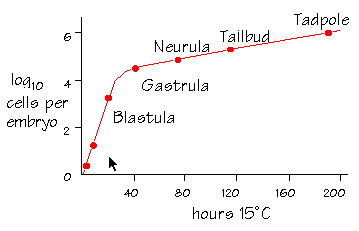






Cleavage:
Rates of Division
Early cleavage divisions in most embryos are also rapid.
One reason for this is that cleaving cells have a modified cell
cycle, in which the two gap
phases, G1
and G2 are
completely omitted, and the cells cycle rapidly between M and S
phases. In addition, because the major cytoskeletal systems of
the cells are largely devoted to mitosis
( microtubule)
and cytokinesis
(microfilaments)
during rapid cleavage division, there is typically an antagonism
between periods of rapid cell division and cell movement. Thus
as the embryo approaches gastrulation,
there is a tremendous slowing in the rate of division (note the
slope of the curve at the below right).
Increase in cell number in the frog embryo vs. time








